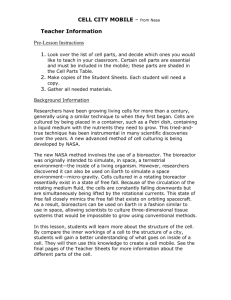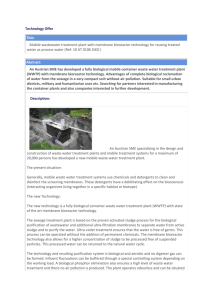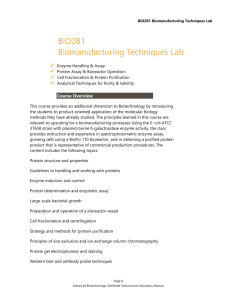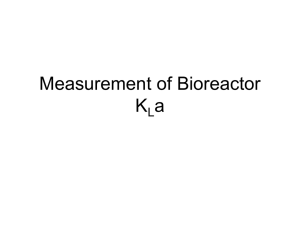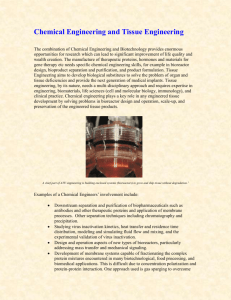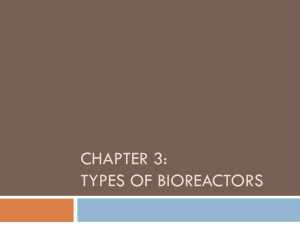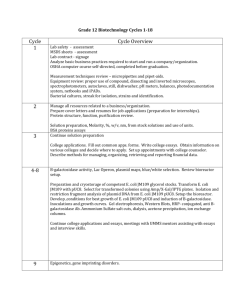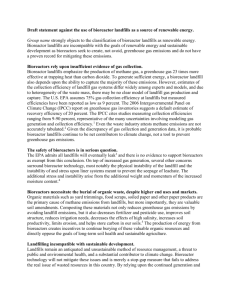Application Note Bringing Fast Process Development to Adherent Cell Culture Processes: Demonstration
advertisement
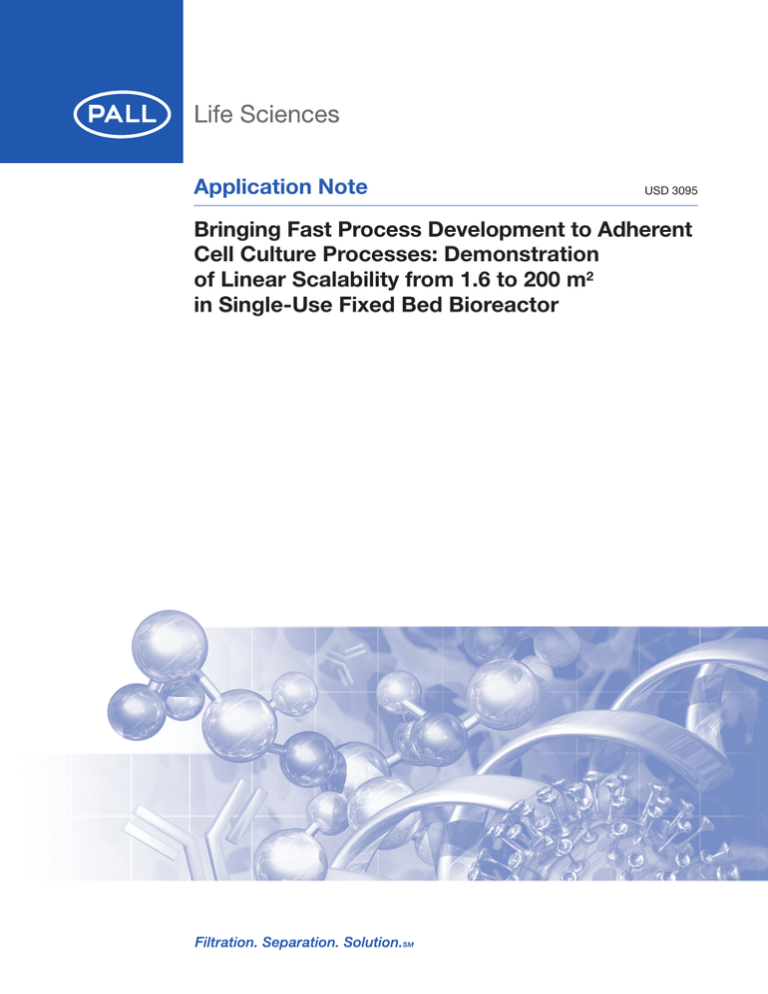
Application Note USD 3095 Bringing Fast Process Development to Adherent Cell Culture Processes: Demonstration of Linear Scalability from 1.6 to 200 m2 in Single-Use Fixed Bed Bioreactor Introduction Today, the vast majority of human and veterinary vaccines are produced using anchorage dependent cell lines (ADCL): primary cells such as chicken embryo fibroblasts (CEF), human diploid cells such as MRC-5 or continuous cell lines such as Vero and MDCK1. Traditionally ADCL have been cultivated in non-controlled, labour-intensive and space-demanding multi-tray stacks (MT) or roller bottles (RB). Microcarrier technologies are one alternative allowing drastic reduction of footprint and labour requirements together with potential increase in productivity by the use of controlled environment in bioreactor. However, the expertise required to transfer a process from 2D supports to microcarriers and the time necessary to develop a process from scratch can be a strong barrier for some companies. An alternative to 2D-supports and microcarriers is the fixed-bed (FB) technology. Although the principles of fixed-bed has been known and used for years in cell culture, its adoption has been quite limited due to intrinsic limitations: difficulties of fixed-bed packing and bioreactor preparation, potential cells or nutrient gradients in the fixed-bed, aeration limitation and difficulties during scale-up of a process2. With the iCELLis® technology, Pall Life Sciences has tackled all these issues: • The iCELLis system is a ready-to-use, single-use bioreactor; • An efficient gas transfer is ensured by an integrated, patented aeration system3; • Fixed-bed design and fluidics have been studied to limit gradients; • A representative scale-down bioreactor is available as a bench-scale bioreactor. As a result, the iCELLis technology is an efficient and cost-effective technology that is proving his worth in biotechnology field, as reflected by increasing number of users and published data4,5,6 This Application Note explains the rationale behind the scale-up principles and demonstrates through an applied case-study using Vero cell line that the scale-up from bench to manufacturing scale can be performed successfully from a 1.6 m2 surface bioreactor (4 L culture) to 200 m2 bioreactor (500 L culture) in a single step. The large scale culture resulted in the production of more than 9.9 x 1011 cells in a single bioreactor, being equivalent to a batch of 770 MT10. iCELLis Fixed-Bed Bioreactors – Rational Scaling Approach The development of the iCELLis technology was orientated from the start towards large scale manufacturing applications. Thus, first efforts have been put in the design and characterization of an efficient large scale bioreactor, resulting in the iCELLis 500 bioreactor. Then, in order to facilitate the process development, a benchscale bioreactor, the iCELLis Nano bioreactor, was developed as a scale-down model of the iCELLis 500 system. The principles followed to design an efficient and scalable technology are detailed in this chapter. Figure 1 iCELLis bioreactor bench (Nano) and manufacturing (500) scales and their modular size fixed bed. LC = Low compaction; HC = High compaction. LC LC HC HC 10 cm 4 m2 2.6 m2 333 m2 500 m2 4 cm 1.6 m2 1.08 m2 0.8 m2 0.53 200 m2 133 m2 2 cm 66 m2 m2 100 m2 Fixed Bed Height and/or compaction increase iCELLis Nano Benchscale 2 Scale -up Scale -down of diameter iCELLis 500 Production scale Fixed Bed-Size Scale-Up The iCELLis fixed bed is made of packed non-woven hydrophilized fibres of polyethylene terephthalate (PET). It is available in 6 sizes from 66 to 500 m2 in iCELLis 500 bioreactors and from 0.53 to 4 m2 in iCELLis Nano bioreactors. The surface is varied by fixed bed height and carriers compaction within a unique model of shell (Figure 1). When shifting from bench scale to manufacturing scale bioreactor, the fixed bed height and compaction are conserved while the diameter is increased. This is the same scale-up principle as chromatography columns. The first step of a typical process development will consist in evaluating the productivity in iCELLis Nano bioreactor of small size (0.53 – 1.6 m2) to determine final manufacturing size target. While the process optimization can be continued in smallest scales of fixed bed, the final process tuning at bench scale must be done in fixed bed of same height and compaction than the manufacturing target. Finally, process conditions will be transferred linearly to iCELLis 500 system. Fixed bed height and compaction will have an influence on cell distribution at seeding. That is why maximum height and compaction have been determined experimentally by Pall to limit the gradient that could eventually appear in a culture. However the homogeneity of the fixed bed colonization should be verified at one point for a given process, as it was done in this case study. Linear Speed Scale-Up In fixed bed technologies, the fluid circulation through fixed bed is of upmost importance as it will directly impact performances of the bioreactor (aeration and shear stress supported by cells) as well as fixed bed homogeneity (cell distribution, nutrients). It is thus mandatory to keep this parameter fixed over bioreactor diameter increase. The design of the iCELLis 500 bioreactor respects this constraint and guarantees a similar liquid flow over any cross section of the fixed bed. The correlation of flow versus centrifugal pump speed was then thoroughly characterized for each height and compaction of fixed-bed and bioreactor scale. Finally, it was empirically determined that linear speeds of 2 cm/s at inoculation and 1 cm/s during the culture would give optimal homogeneity while keeping a very low shear stress. Thus, for the end-user, scaling-up of the linear speed through fixed bed is just a matter of applying the recommendations provided by Pall technical support7. In the iCELLis technology, the O2 transfer from gas phase to medium is ensured by the formation within the bioreactor of a falling film3. The very small thickness of this falling film allows an increased gas transfer, supressing the need for an external aeration loop used in other technologies. At both large and small scale, the falling film height can be modulated between 0 and 10 cm height (note this parameter is not the fixed bed height). Thus the kLa can be adapted without changing agitation speed and with no impact on other culture parameters either at small and large scales. Scale-Up of Medium Feed The small working volume and the principle of immobilization of cells in the fixed bed makes the iCELLis 500 system a reactor of choice for perfusion processes. However, the bioreactor can still be operated in batch mode if perfusion process does not bring any particular value. In this case the bioreactor is connected to a medium tank in a closed recirculation loop (RL) and medium is circulated at a rate that ensures homogeneity between the tank and the bioreactor. It is referred to as Recirculated batch mode. Either in Perfusion of Recirculated batch mode, the seeding will take place without any medium recirculation. Cells will be introduced in a total volume of ~70 L and will stay in this reduced volume to take advantage of cell concentration factor for growth start. After growth has started the perfusion or the recirculation will be triggered based on metabolite monitoring or time. The optimal perfusion or recirculation rate will be determined during development phases in iCELLis Nano bioreactor. The scale-up rule of thumb for this parameter is to maintain the ratio of volume feed per surface (thus per cell) constant. www.pall.com/biopharm 3 Materials and Methods Cell Line and Culture Reasgents The case-study was realized with Vero (WHO) cells (ECCAC – cat. 88020401), cultured using DMEM, 4.5 g/L of glucose (GIBCO) supplemented with 5% FBS (South American origin, GIBCO). Cell passaging was done using TrypLE◆ Express (Life Technologies). Routine Subculturing and Seed Train Preparation for iCELLis 500/200 m2 Bioreactor Vero cells were subcultured in T-Flasks and Multitray (MT) at a medium/surface ratio of 0.25 mL/cm2. In static vessels, cells were routinely seeded at densities between 15,000 and 30,000 cells/cm2, then incubated at 37 °C, 5% CO2, for 4 or 3 days respectively. Cell harvest from MT consistently yielded 200,000 cells/cm2 at confluence. For the inoculation of the iCELLis 500/200 m2 bioreactor a seeding density of 5,000 cells/cm2 was targeted. The following seed train, from vial to iCELLis 500 bioreactor inoculation was: 106 cells from thaw seeded in 1 TF150 for 4 days, followed by expansion in 2 TF300 (4 days culture), then 1 MT10 (6300 cm2, 3 days culture), then 8 MT10 and finally harvest and pooling of cells for inoculation of the bioreactor. This last operation was realized in less than 1 h by 2 operators working under Class II laminar flow hood. Bioreactor Preparation, Seeding and Culture Conditions For medium transport in clean rooms and recirculation in large scale culture, Jet drive stainless steel container and Jet mixer 500 L biocontainers (Pall) were used. All connections to and from the iCELLis 500 system were done aseptically using C-flex welder. One day prior to inoculation, iCELLis 500/200 m2 bioreactor (4 cm high fixed bed, high compaction) was unpacked and placed on iCELLis 500 controller (Pall). The bioreactor was connected aseptically to medium container and other ancillaries. It was then filled with 70 L of culture media to equilibrate overnight. At the time of inoculation, cells from the preculture were pooled into 2 L of culture medium in a 5 L 2D biocontainer (Pall) and the biocontainer was welded to the bioreactor INOCULATION Line. Agitation speed was increased to obtain a linear speed of 2 cm/s through the fixed bed and cells were pumped into the bioreactor under constant agitation. After 1 hour of cell adherence in the fixed bed, the agitation speed was reduced to 1 cm/s. Medium and cells from the same pool were used to start similarly the iCELLis Nano system culture. The culture parameters applied in each bioreactor scale were defined according to principles exposed in previous chapter. They are summarized in Table 1. These parameters were monitored in-line in the bioreactor using non-invasive single-use optical probes for pH and DO and Thermowell for the temperature. pH was regulated automatically through CO2 addition in gas overlay and NaOH (1N) addition in culture supernatant. Dissolved Oxygen was measured before and after fixed bed and maintained above 70% Air Saturation by injecting a constant Air flow in the gas overlay, supplemented by O2 flow based on cell demand. Culture Monitoring The culture process applied in the iCELLis 500/200 m2 bioreactor was investigated in iCELLis Nano bioreactor over several cultures. 3 repeats of the final process were done at small scale in the same fixed-bed height (4 cm high, high compaction), one of them being realized in parallel of the large scale run. Additionally, MTs were seeded as standard controls. Metabolites were measured by sampling the culture supernatant and analysis in a BioProfile 400 (Nova Biomedical). At the end of the culture, the bioreactor was open in non-sterile conditions and iPACK PET carriers were sampled at different locations for direct cell count. Cell count on carriers was obtained by incubating them in lysis buffer A (Chemometec) for 5 min at room temperature, vortexing 1 min and counting of released nuclei with haemocytometer. On-line cell growth monitoring in the iCELLis 500 bioreactor was obtained by capacitance measurement in bioreactor. The capacitance signal is directly proportional to live cells and in-line measurement in the iCELLis 500 bioreactor was obtained using a single-use sensor integrated to the bioreactor. 4 Table 1 Culture parameters in iCELLis Nano and iCELLis 500/200 m2 bioreactors cultures. Surface Volume at inoculation Total culture volume Recirculation flow-rate 1 Recirculation flow-rate 2 Agitation for 1 cm/s linear speed (48 h) Agitation for 2 cm/s linear speed (80 h) Falling film height Temperature setpoint Dissolved Oxygen Setpoint pH setpoint iCELLis Nano Bioreactor iCELLis 500 Bioreactor 1.6 m 0.6 L 4L 1.9 mL/min 3.6 mL/min 780 RPM 1180 RPM 6 cm 36.5 °C > 70 % Air Saturation 7.30 +/- 0.05 200 m2 71.9 L 500 L 240 mL/min 450 mL/min 220 RPM 385 RPM 10 cm 2 From Bench Scale to Industrial Scale in a Single Step Using the iCELLis platform, a VERO cell cultivation process was developed from bench to industrial scale. The process was first intensively tested at bench scale (0.5 to 1.6 m2) to define optimal seeding conditions and maximize cell growth. The parameters defined at bench scale were then transferred into a production scale bioreactor of 200 m2 (iCELLis 500/200 m2 bioreactor). Optimizing Seeding Density In a preliminary step the growth of the Vero was characterized in MTs. Culture process was then transferred to a iCELLis Nano bioreactor. In the iCELLis Nano system, it was demonstrated that cell growth can start at seeding densities as low as 500 cell/cm2 whereas in MTs the growth generally does not start below 2,000 cells/cm2. This performance is obtained by concentrating cells in a small culture volume at the moment of seeding. The concentration factor during growth start phase is up to 17 times higher in the iCELLis system than MTs. After cell growth has started, the culture volume is increased, either with a recirculation loop or with by perfusion. This particularity of fixed-bed technology allows a drastic reduction of seed train (Figure 7). After 2 repeats of Vero cell growth in a 1.6 m2 iCELLis Nano bioreactor, the culture process was directly transferred in large scale bioreactor by following the rationale exposed previously: same fixed-bed height and compaction, same liquid and linear speed over the process and conservation of culture conditions (pH, D.O, temperature, medium volume/surface ratio and dilution rate). For the large scale experiment it was decided to target an inoculation density of 5,000 cells/cm2 as a balance between workload and culture duration. Cell Growth In total, the large scale bioreactor contained 9.9 x 1011 cells at the end of the culture. The iCELLis 500/200 m2 bioreactor culture yielded a cell density of 490,000 cells/cm2. This cell density was in high range of densities obtained in iCELLis Nano bioreactor demonstrating the relevance of this scale down system. Compared to traditional MTs, the iCELLis system cell yield was more than 2-fold higher than average cell yield from the MT confluent cultures (Figure 2). www.pall.com/biopharm 5 Figure 2 Comparison of final cell density in multi-trays, iCELLis Nano 1.6 m2 and iCELLis 500/200 m2 bioreactors (Error Bar: Min and Max values of 3 runs, only 1 value available for iCELLis 500 system) 500000 MTs 450000 iCELLis Nano bioreactor iCELLis 500 bioreactor Cells per cm2 400000 350000 300000 250000 200000 150000 100000 50000 0 This cell density was obtained over the same time of culture for all vessels (6.9 days) allowing comparison of global Doubling Time (DT). Global DT was reduced by up to 20% in iCELLis system (1.04 and 1.16 day in iCELLis 500 and iCELLis Nano bioreactors respectively) compared to MT (1.29 day). This better performance in iCELLis bioreactors reflects the advantage of maintaining controlled environment (pH and DO) in bioreactor compared to static conditions of MT. Demonstrating further impact of controlled environment on cell metabolism, the cell yield per glucose consumed was more than 2-fold higher in iCELLis system versus MT (56,800 million cells per mol of glucose) and was identical at both iCELLis bioreactor scales (160,700 million cells per mol of glucose). The follow-up of metabolites in the culture showed similar trends in large and small scale bioreactors (Figure 3 and Figure 4). As shown in the trends, glucose consumption and growth began quickly in the first 24 h as cells were kept in a reduced volume. After 48 h the RL was started and resulted in the increase of glucose concentration observed between 30 h and 50 h. Afterward the glucose was consumed down to 11 mM while the lactate ended at 21 mM. Figure 3 Glucose concentration in iCELLis 500/200 m2 and control iCELLis Nano bioreactors culture 30 Glucose concentration (mM) 25 20 15 10 5 0 0 20 40 60 iCELLis 500 bioreactor 80 100 120 Time of culture (h) Time iCELLis 500 Loop iCELLis Nano Loop 6 140 160 180 iCELLis Nano bioreactor Figure 4 Lactate concentration in iCELLis 500/200 m2 and control iCELLis Nano bioreactors culture. 30 Lactate concentration (mM) 25 20 15 10 5 0 0 20 40 60 80 100 120 T Time ime of culture (h) iCELLis 500 Loop iCELLis 500 bioreactor 140 160 180 iCELLis Nano bioreactor iCELLis Nano Loop 200 5 180 4.5 160 4 140 3.5 120 3 100 2.5 80 2 60 1.5 40 1 20 0.5 0 0 20 40 60 80 100 120 140 160 0 180 Biomass First order differential coefficiant (pF/cm/h) Biomass capacitance (pF/cm) Figure 5 Cell growth monitoring in iCELLis 500/200 m2 bioreactors by in-line capacitance measurement and differential coefficient calculation of capacitance signal. Time of culture (h) iCELLis 500 capacitance signal Differential coefficient www.pall.com/biopharm 7 In-line monitoring of biomass by capacitance in the bioreactor showed an increase in growth rate up to 70 h, followed by a logarithmic growth until 90-100 h and significant decrease after 100 h as shown by differential coefficient calculation (Figure 5). At this point, the growth was half-way from confluence as capacitance has then increased from 100 pF/cm to 180 pF/cm. It is probable that the inflexion in growth curve observed was due to the accumulation of lactate in the media, reaching 13 mM at this time of culture. This data shows that the growth could be further optimized with a perfusion feeding strategy to maintain DT at its maximum value. By design, the iCELLis bioreactor easily allows perfusion process and optimization can be done in iCELLis Nano system before transfer at large scale. Cell Distribution in Fixed-Bed At the end of the culture both the iCELLis Nano and the iCELLis 500 bioreactors were dismantled to sample carriers at different levels and positions of the reactors and count cells. Cell distribution was evaluated by comparing counts vertically (Figure 6, columns) and horizontally (Figure 6, error bars). As expected, there was a cell gradient from bottom to top of the reactor. However, the average vertical variability was only 16% in the iCELLis 500 bioreactor and 28% in the iCELLis Nano bioreactor. Similarly, the horizontal variability was comprised between 10 and 17% for both scales. The cell distribution in iCELLis 500 bioreactor was thus very similar to the one obtained in iCELLis Nano bioreactor. The gradient observed was fewer than 20% and these local variations in cell density are comparable to variations in surface utilization that can be classically observed in MT. We can conclude that the whole fixed-bed was participating to the culture as in a static culture. Figure 6 Average cell distribution in iCELLis Nano and iCELLis 500/200 m2 bioreactors fixed bed at the end of the culture. Cell count at each level (Bottom, Middle, Top) is expressed as percentage of Bottom absolute cell count. Error bars are relative standard deviations of cell counts of different positions of a given level (iCELLis Nano bioreactor: 3 positions, iCELLis 500 bioreactor: 7 positions). 120 % of bottom count 100 80 60 40 20 0 Bottom iCELLis Nano bioreactor Middle Top iCELLis 500 bioreactor Conclusion In this case-study, we first transferred a MT-based process to a bench-scale fixed-bed bioreactor, then demonstrated the scalability between bench scale and manufacturing scale bioreactors by increasing batch size 125 times in a single step. The process was tested 3 times at bench-scale in the iCELLis Nano (1.6 m2 fixed bed) bioreactor to ensure reproducibility, then was transferred directly to manufacturing scale (200 m2 fixed bed), achieving a scale-up linear to fixed bed surface increase. This linearity was confirmed in terms of total cell produced, metabolites evolution and cell distribution. This demonstration confirms that the iCELLis Nano bioreactor is a relevant scale-down of the manufacturing scale iCELLis 500 bioreactor. 8 In addition, the whole case-study was realized in less than 2 months thanks to process scale-up rationale developed by Pall through iCELLis platform characterization. This clearly shows how iCELLis technology can dramatically reduce process development time. Indeed, different process conditions can be tested at high throughput at bench-scale with the insurance of a linear scalability at the time of scaling-up the process to industrial bioreactor. Another practical demonstration of this case-study is the process simplification and intensification when compared to 2D vessels-based processes. The iCELLis bioreactor inoculation is a simple and straightforward step thanks to its simplicity of operation, possible with its advanced design and characterization that can take place in class C rooms. The very low seeding density (3 to 10 time reduction vs. MTs) allows skipping several amplification steps in seed train production compared to MTs process (Figure 7). Meanwhile, the process control increases final cell density by 2-fold compared to MTs. Together with this increase of productivity comes a dramatic impact on footprint (total footprint of iCELLis platform and 500 L Jet mixer ≈7 m2), on manpower (2 operators are enough to setup and manage a complete process equivalent to thousands of roller bottles) as well as on process safety (more than 900 open phase manipulations are replaced by a dozen aseptic connections from seeding to harvest). In conclusion, the iCELLis technology allows a shorten time for process development, a more efficient manufacturing process and a more cost-effective option than traditional 2D supports or microcarriers-based processes. This can be a determinant asset in the vaccine manufacturer landscape which evolves rapidly to address a rising global demand for higher volumes of existing vaccines and vaccines for new indications8,9. Figure 7 Simplification of seed train in iCELLis technology. iCELLis seed train compared to a RB process based on 1/5 split ratio. References 1. Aunins JG., Viral Vaccine Production in Cell Culture. Encyclopedia of Industrial Biotechnology: Bioprocess, Bioseparation, and Cell Technology. Flickinger MC, Ed. Wiley: Hoboken, NJ, 2010: 1–35 2. Pörtner R., Barradas O., Cultivation of Mammalian Cells in Fixed-Bed Reactors. Animal Cell Biotechnology. Methods Biotechnol. 24, 2007: 353–369 3. Castillo Fernandez JA., (2007), PCT/EP2006/066981 4. Knowles S., et al., Linear Scalability of Virus Production in Integrity iCELLis Single- Use, Fixed-Bed Bioreactors from Bench Scale to Industrial Scale. ESACT 2013. Lille, France, 23–26 June 2013. 5. Lesch, et al., iCELLis Fixed-Bed Technology for Adherent Cells in an Efficient, Scalable System for Viral Vector Production. American Society for Gene and Cell Therapy, New Orleans, LA, 2015. 6. Lennaertz A, et al. Adeno Associated Virus Production Using a Disposable, Fixed- Bed Bioreactor from Bench-Scale to Industrial Scale. BMC Proceedings 7(S6) 2013: 59; www. biomedcentral.com/1753-6561/7/S6/P59. 7. Application note fluid circulation 8. Carlson B. The Expanding Vaccine Market. Pharm. Process. 16 January 2012. 9. The Vaccine Industry in Figures; www. vaccineseurope.eu/about-vaccines-europe vaccines-europe-in-figures. www.pall.com/biopharm 9 Visit us on the Web at www.pall.com/biopharm E-mail us at bioreactors@pall.com Corporate Headquarters Port Washington, NY, USA +1.800.717.7255 toll free (USA) +1.516.484.5400 phone biopharm@pall.com e-mail International Offices Pall Corporation has offices and plants throughout the world in locations such as: Argentina, Australia, Austria, Belgium, Brazil, Canada, China, France, Germany, India, Indonesia, Ireland, Italy, Japan, Korea, Malaysia, Mexico, the Netherlands, New Zealand, Norway, Poland, Puerto Rico, Russia, Singapore, South Africa, Spain, Sweden, Switzerland, Taiwan, Thailand, the United Kingdom, the United States, and Venezuela. Distributors in all major industrial areas of the world. To locate the Pall office or distributor nearest you, visit www.pall.com/contact. European Headquarters Fribourg, Switzerland +41 (0)26 350 53 00 phone LifeSciences.EU@pall.com e-mail The information provided in this literature was reviewed for accuracy at the time of publication. Product data may be subject to change without notice. For current information consult your local Pall distributor or contact Pall directly. Asia-Pacific Headquarters Singapore +65 6389 6500 phone sgcustomerservice@pall.com e-mail © 2015, Pall Corporation. Pall, , and iCELLis are trademarks of Pall Corporation. ® indicates a trademark registered in the USA and TM indicates a common law trademark. Filtration.Separation.Solution. is a service mark of Pall Corporation. ◆TrypLE is a trademark of Life Technologies Corporation and BioProfile is a trademark of Nova Biomedical. 11/15, PDF, GN15.6399 USD 3095
